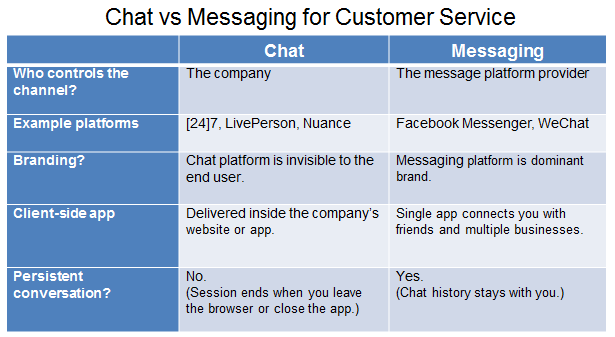
It’s amazing how quickly things are moving in the customer service space: new channels (e.g. chat & bots), new behavior (e.g. a preference for text, venting on Twitter) and new players (e.g. Facebook and Salesforce). It’s a challenge to understand how these changes will work together to reshape the industry. New terminology can help our thought process, if we all agree on the meaning. Conversely, ambiguity about words like “digital” or “chat” or “call” makes the navigation harder.
we’ve compiled a list of terms that are either new to the space or have a recently changed meaning. This is not a simple dictionary-style listing of common terms (you can find that in many other places). We’re just tackling the stuff that is still hot out of the oven!
Canonical
This is a word that I remember from decades ago in a literature class and it’s great to see it take on new life. In the customer service context, “canonical” means that an interaction is the “official” record between you and a company. I think people are also using it to imply that it is a complete record, although this is not always true.
It used to be that canonical information was kept internal to the company. Here is VC blogger Thomas Tunguz using it in that sense:
“Systems of record are the single source of truth about a particular department or company. A CRM is the canonical source of sales information; the ERP system is the canonical source of a company’s financial information.” [emphasis added]
The new trend is to share the official record with customers, thus making customer service more efficient. Here is David Marcus, head of Facebook Messenger, talking about airline KLM using Messenger:
“…flyers will be able to automatically receive their itinerary, flight updates, check-in notifications, get their boarding passes, even rebook flights when needed, and communicate with the airline all from one contextual, canonical thread.” [emphasis added]
And here he is using it to contrast with email:
“…email is completely broken. Look at the traditional e-commerce journey: you go to a website. You have to create an account – that’s one email. You add something to your shopping cart and check out – that’s another email. The package ships – that’s another email. When it arrives, that’s another. That’s four emails that are distinct threads that are not canonical.”
Chat vs. Messaging
Although “chat” and “messaging” are interchangeable in casual usage, they are in fact, two different approaches to customer service.
A company adds “chat” to its website or mobile app by buying, from a 3rd party, a service that will live solely on that company’s site or app. Whereas, “messaging” is something that requires the company to partner with a platform that gives consumers a single interface (on the web or phone) for contacting both friends and businesses. The company does not pay for the platform and does not have control over it. (Those definitions aren’t official, but seem to be the consensus of the analysts and industry folks I spoke to.)
The chart below fleshes out the comparison.

Digital Channels
This is really an “anti-entry” in the lexicon. In other words, a term we need to stop using.
A central challenge in managing customer service today is the need to decide where to put limited resources. To do that, it’s critical to know which channels are growing and which are shrinking. Industry analysts have been eager to provide information to fuel those decisions. In presenting their data, there is a natural tendency to summarize results into tidy answers.
As an example consider this chart showing the evolution of channel usage:

That chart comes from a widely cited report by Dimension Data. We’ve reference it on his blog many times, in fact. Along with that chart, the report also includes the statement that 35% of all interactions are now on “digital” channels and the bold prediction that “digital interactions will overtake voice by the end of 2016”.
But “digital” in this context is meaningless. All the channels listed – even voice – are delivered with digital technology!
How did we get into this mess? The problem has a far larger scope than just industry analysts. In common use, the word “digital” has an informal meaning of “modern” or “new” for many years. But being digital doesn’t make something new. Fax machines are digital. Heck, even Morse code is digital.
We clearly need better terminology in this area, but there are no easy answers at this point.
Virtual Queuing vs. Virtual Hold vs. Call-Backs
When it comes to reducing hold-time in the call-center, there are a number of terms that overlap each other, which can be confusing.
Virtual queuing is basically the “take-a-number” approach. In the real world that means you can go sit down, relax and wait for your turn to be announced over a loudspeaker. In the phone world, it means you can hang up, go about your day, and wait for the call-back.
Virtual queuing describes any system where you can keep your place in line without having to stay on the phone.
People sometimes use the term “Virtual Hold” when talking about virtual queuing. But Virtual Hold is the specific product of a company called “Virtual Hold Technology”. (This is kind of like the relationship between “kleenex” and “tissue”.)
The related term “call-back” (sometimes written as “callback”) is easy to understand because it’s part of our vocabulary for plain old person-to-person calls: “Hi. Can’t talk right now. Call you back in 5?”
When used for a “person-to-company” call, call-backs can take several forms, but what’s common is that the direction of the call gets reversed. That is, you want to talk to Acme, but the call comes from Acme to your phone.
Here’s an important point: virtual queuing always requires a call-back, but the reverse is not true. That is, companies might offer call-backs, but you would still end-up waiting on hold after you answered the call.
The image below shows how virtual queuing and call-backs work together in a call timeline.

Download “The New Customer Service Lexicon” to Keep Reading
If you’re trying to make sense of where customer service technology is headed, the definitions and explanations in this whitepaper will be very helpful. Other entries:
- Bots vs. AI
- Conversational Commerce
- Voice Shrinkage
- Virtual Agents vs Intelligent Assistant



